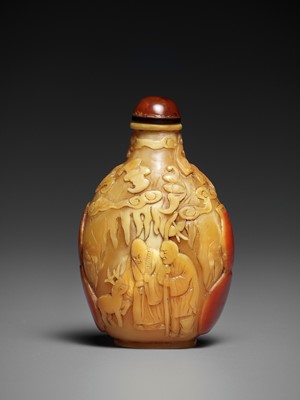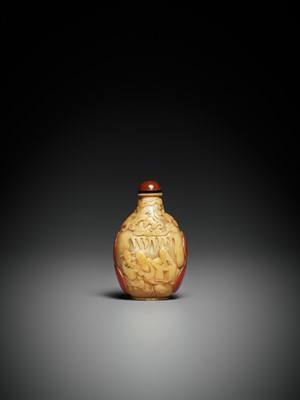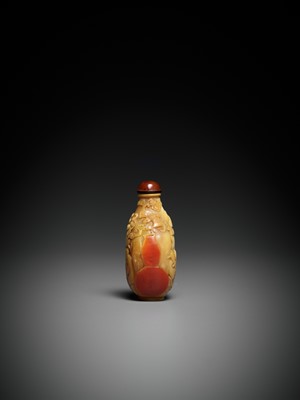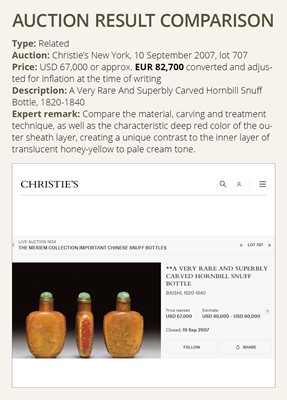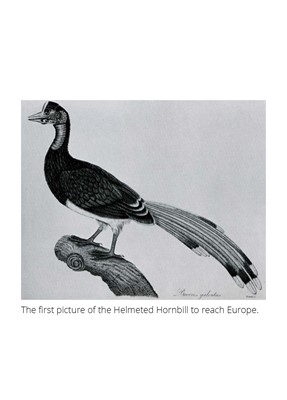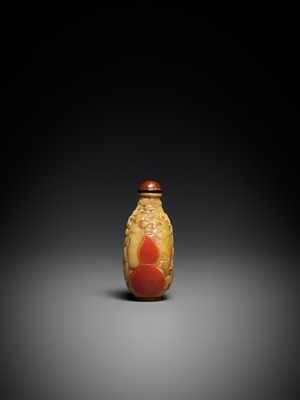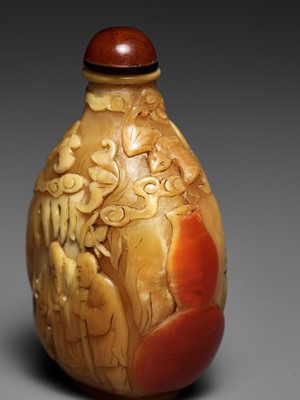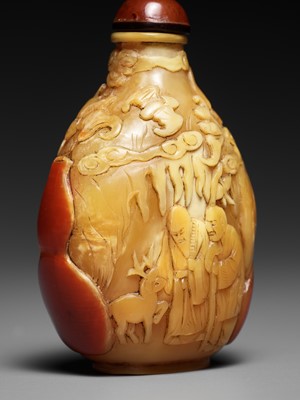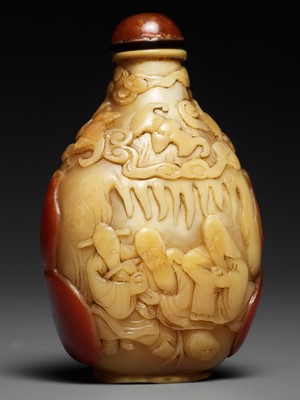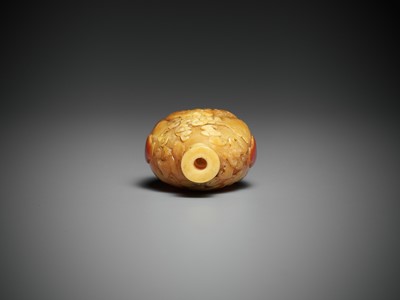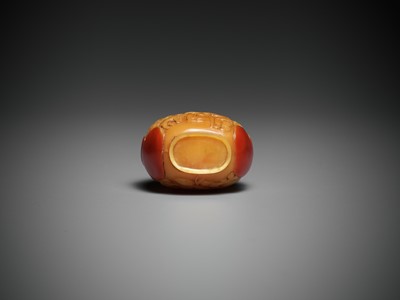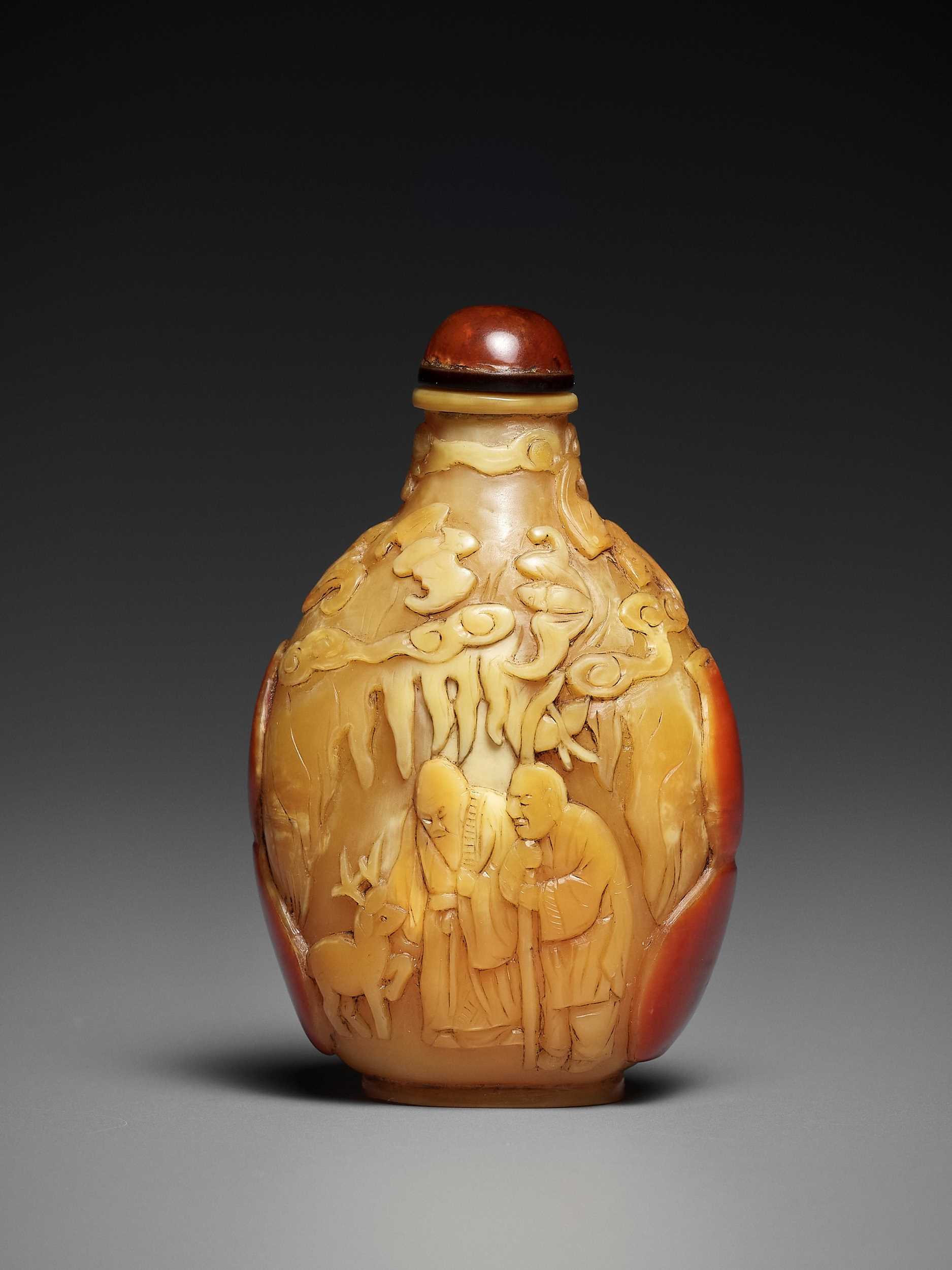10th Dec, 2022 11:00
Asian Art Holiday Sale
232
Ɏ A RARE HORNBILL ‘SANXING’ SNUFF BOTTLE, EARLY 19TH CENTURY
十九世紀罕見鶴頂紅“福祿壽三星”鼻烟壺
Sold for €2,080
including Buyer's Premium
Opinion: The superb color and excellent polish of the present bottle suggest that it was created by using the ancient and today lost method of treating hornbill (see detailed note below), giving the material a rich translucency and protecting it from cracking over time. The carved decoration is well rendered and rare to find in such an elaborate manner on hornbill snuff bottles. Finally, the ovoid form, quite different from the rectangular forms commonly found, indicates that this is an early yet fine example from this rare group.
China. Well hollowed, the ovoid body supported on a short oval foot and rising to a cylindrical neck with everted rim. Finely carved in relief to one side with the three star gods, the Sanxing, seated in a relaxed manner and holding wine cups, and to the other with Shoulao tending to his deer while his attendant is holding his cane with the double gourd, the shoulder and neck carved continuously with five bats amid clouds. The short sides each with a large double gourd vessel retaining the characteristic deep red color of the outer sheath layer of the hornbill, creating a unique contrast to the inner layer of translucent honey-yellow to pale cream tone.
Provenance: Collection particulière dans le département Eure-et-Loir, France.
Condition: Very good condition with significant old wear, natural imperfections to the material, few microscopic age cracks, and few minuscule nicks. Magnificent natural patina overall.
Stopper: Translucent reddish-amber hardstone with black platelet, fine hornbill spoon
Weight: 23.9 g
Dimensions: Height including stopper 61 mm, Diameter neck 13 mm and mouth 5 mm
Hornbill was a highly valued material in China well before snuff bottles came into fashion in the Qing dynasty, after tobacco was introduced from the West in the early 18th century. The precise value is listed in the official regulations of the Ming dynasty, which set it for a single piece of ‘ho-ting’ (the term given to the material by Ming scholars, writing it with the characters for ‘crane’ and for ‘head’) at a thousand cash, the same amount given for half an ounce of precious coral beads, or a fifth of an ounce of rare seed pearls. This also shows that hornbill was worth far more than elephant ivory at that time, for the latter was valued at five hundred cash per pound, while it would have taken a great many pieces of ho-ting to make a pound, especially since the term was sometimes applied to the red sheathing alone.
It is thought that there were once two distinct methods of treating hornbill, the solid casque with the tough red sheath that sits atop the upper beak, protecting the brain of the bird. The secret of the first method appears to have been lost but may have involved heating and perhaps permeating the material with some preservative. All known early pieces seem to have been handled this way, including snuff bottles. This treatment preserves the material very well, giving it a rich translucency and strength. We can only infer this preliminary manipulation from the finished product, since no direct information about the techniques of treating hornbill ivory has been recorded. Any special methods used by Chinese craftsmen were always kept as closely guarded secrets, by the guilds involved, to forestall outside competition. The second method involved carving the material directly, which left the surface prone to cracking.
Auction result comparison:
Type: Related
Auction: Christie’s New York, 10 September 2007, lot 707
Price: USD 67,000 or approx. EUR 82,700 converted and adjusted for inflation at the time of writing
Description: A Very Rare And Superbly Carved Hornbill Snuff Bottle, 1820-1840
Expert remark: Compare the material, carving and treatment technique, as well as the characteristic deep red color of the outer sheath layer, creating a unique contrast to the inner layer of translucent honey-yellow to pale cream tone.
十九世紀罕見鶴頂紅“福祿壽三星”鼻烟壺
中國。掏膛良好,直頸,扁平,削肩,橢圓形圈足。一面浮雕福祿壽三星悠閒端坐,端著酒杯;另一面壽老撫鹿,身側侍者手持葫蘆與手杖,身邊飛舞著五隻蝙蝠。兩側各有一個大葫蘆,保留了鶴頂紅特有的深紅色,與半透明的蜜色內層形成獨特的對比。
專家注釋:此鼻烟壺色澤上乘瑩潤,表明它是使用已失傳的鶴頂紅角處理方法製成的,使材料具有半透明性,並防止其隨著時間的推移而開裂。鶴頂紅鼻烟壺上的浮雕精美,難得一見。最後,與常見的矩形完全不同的卵形表明這是一件鶴頂紅雕刻初期的產物。
來源:法國 Eure-et-Loir省私人收藏。
品相:品相極好,有明顯的磨損,材料自然瑕疵,輕微年代裂縫和小劃痕。整體呈現瑩潤的自然包漿。
壺蓋:半透明琥珀色硬石,黑色托片,鶴頂紅雕小勺
重量:23.9 克
尺寸:高 (含蓋)61 毫米,頸部直徑13 毫米及壺口直徑5 毫米
鶴頂紅在清代鼻烟壺流行之前,早在十八世紀初從西方傳入煙草,在中國就已備受推崇。明朝的官規中列出了準確的價值,將其定為單片“鶴頂”一千金,相當於半盎司珍貴珊瑚珠或五分之一盎司稀有珍珠的價值。這也說明鶴頂紅在當時的價值遠超象牙,因為後者價值五百現金一磅。
拍賣結果比較:
形制:相近
拍賣:紐約佳士得,2007年9月10日,lot 707
價格:USD 67,000(相當於今日EUR 82,700)
描述:1820-1840年罕見鶴頂紅鼻烟壺
專家評論:比較材料、雕刻和處理技術,以及外鞘層特有的深紅色,與內層半透明的蜜黃色至淡奶油色形成獨特的對比。
Opinion: The superb color and excellent polish of the present bottle suggest that it was created by using the ancient and today lost method of treating hornbill (see detailed note below), giving the material a rich translucency and protecting it from cracking over time. The carved decoration is well rendered and rare to find in such an elaborate manner on hornbill snuff bottles. Finally, the ovoid form, quite different from the rectangular forms commonly found, indicates that this is an early yet fine example from this rare group.
China. Well hollowed, the ovoid body supported on a short oval foot and rising to a cylindrical neck with everted rim. Finely carved in relief to one side with the three star gods, the Sanxing, seated in a relaxed manner and holding wine cups, and to the other with Shoulao tending to his deer while his attendant is holding his cane with the double gourd, the shoulder and neck carved continuously with five bats amid clouds. The short sides each with a large double gourd vessel retaining the characteristic deep red color of the outer sheath layer of the hornbill, creating a unique contrast to the inner layer of translucent honey-yellow to pale cream tone.
Provenance: Collection particulière dans le département Eure-et-Loir, France.
Condition: Very good condition with significant old wear, natural imperfections to the material, few microscopic age cracks, and few minuscule nicks. Magnificent natural patina overall.
Stopper: Translucent reddish-amber hardstone with black platelet, fine hornbill spoon
Weight: 23.9 g
Dimensions: Height including stopper 61 mm, Diameter neck 13 mm and mouth 5 mm
Hornbill was a highly valued material in China well before snuff bottles came into fashion in the Qing dynasty, after tobacco was introduced from the West in the early 18th century. The precise value is listed in the official regulations of the Ming dynasty, which set it for a single piece of ‘ho-ting’ (the term given to the material by Ming scholars, writing it with the characters for ‘crane’ and for ‘head’) at a thousand cash, the same amount given for half an ounce of precious coral beads, or a fifth of an ounce of rare seed pearls. This also shows that hornbill was worth far more than elephant ivory at that time, for the latter was valued at five hundred cash per pound, while it would have taken a great many pieces of ho-ting to make a pound, especially since the term was sometimes applied to the red sheathing alone.
It is thought that there were once two distinct methods of treating hornbill, the solid casque with the tough red sheath that sits atop the upper beak, protecting the brain of the bird. The secret of the first method appears to have been lost but may have involved heating and perhaps permeating the material with some preservative. All known early pieces seem to have been handled this way, including snuff bottles. This treatment preserves the material very well, giving it a rich translucency and strength. We can only infer this preliminary manipulation from the finished product, since no direct information about the techniques of treating hornbill ivory has been recorded. Any special methods used by Chinese craftsmen were always kept as closely guarded secrets, by the guilds involved, to forestall outside competition. The second method involved carving the material directly, which left the surface prone to cracking.
Auction result comparison:
Type: Related
Auction: Christie’s New York, 10 September 2007, lot 707
Price: USD 67,000 or approx. EUR 82,700 converted and adjusted for inflation at the time of writing
Description: A Very Rare And Superbly Carved Hornbill Snuff Bottle, 1820-1840
Expert remark: Compare the material, carving and treatment technique, as well as the characteristic deep red color of the outer sheath layer, creating a unique contrast to the inner layer of translucent honey-yellow to pale cream tone.
十九世紀罕見鶴頂紅“福祿壽三星”鼻烟壺
中國。掏膛良好,直頸,扁平,削肩,橢圓形圈足。一面浮雕福祿壽三星悠閒端坐,端著酒杯;另一面壽老撫鹿,身側侍者手持葫蘆與手杖,身邊飛舞著五隻蝙蝠。兩側各有一個大葫蘆,保留了鶴頂紅特有的深紅色,與半透明的蜜色內層形成獨特的對比。
專家注釋:此鼻烟壺色澤上乘瑩潤,表明它是使用已失傳的鶴頂紅角處理方法製成的,使材料具有半透明性,並防止其隨著時間的推移而開裂。鶴頂紅鼻烟壺上的浮雕精美,難得一見。最後,與常見的矩形完全不同的卵形表明這是一件鶴頂紅雕刻初期的產物。
來源:法國 Eure-et-Loir省私人收藏。
品相:品相極好,有明顯的磨損,材料自然瑕疵,輕微年代裂縫和小劃痕。整體呈現瑩潤的自然包漿。
壺蓋:半透明琥珀色硬石,黑色托片,鶴頂紅雕小勺
重量:23.9 克
尺寸:高 (含蓋)61 毫米,頸部直徑13 毫米及壺口直徑5 毫米
鶴頂紅在清代鼻烟壺流行之前,早在十八世紀初從西方傳入煙草,在中國就已備受推崇。明朝的官規中列出了準確的價值,將其定為單片“鶴頂”一千金,相當於半盎司珍貴珊瑚珠或五分之一盎司稀有珍珠的價值。這也說明鶴頂紅在當時的價值遠超象牙,因為後者價值五百現金一磅。
拍賣結果比較:
形制:相近
拍賣:紐約佳士得,2007年9月10日,lot 707
價格:USD 67,000(相當於今日EUR 82,700)
描述:1820-1840年罕見鶴頂紅鼻烟壺
專家評論:比較材料、雕刻和處理技術,以及外鞘層特有的深紅色,與內層半透明的蜜黃色至淡奶油色形成獨特的對比。
Zacke Live Online Bidding
Our online bidding platform makes it easier than ever to bid in our auctions! When you bid through our website, you can take advantage of our premium buyer's terms without incurring any additional online bidding surcharges.
To bid live online, you'll need to create an online account. Once your account is created and your identity is verified, you can register to bid in an auction up to 12 hours before the auction begins.
Intended Spend and Bid Limits
When you register to bid in an online auction, you will need to share your intended maximum spending budget for the auction. We will then review your intended spend and set a bid limit for you. Once you have pre-registered for a live online auction, you can see your intended spend and bid limit by going to 'Account Settings' and clicking on 'Live Bidding Registrations'.
Your bid limit will be the maximum amount you can bid during the auction. Your bid limit is for the hammer price and is not affected by the buyer’s premium and VAT. For example, if you have a bid limit of €1,000 and place two winning bids for €300 and €200, then you will only be able to bid €500 for the rest of the auction. If you try to place a bid that is higher than €500, you will not be able to do so.
Online Absentee and Telephone Bids
You can now leave absentee and telephone bids on our website!
Absentee Bidding
Once you've created an account and your identity is verified, you can leave your absentee bid directly on the lot page. We will contact you when your bids have been confirmed.
Telephone Bidding
Once you've created an account and your identity is verified, you can leave telephone bids online. We will contact you when your bids have been confirmed.
Classic Absentee and Telephone Bidding Form
You can still submit absentee and telephone bids by email or fax if you prefer. Simply fill out the Absentee Bidding/Telephone bidding form and return it to us by email at office@zacke.at or by fax at +43 (1) 532 04 52 20. You can download the PDF from our Upcoming Auctions page.
How-To Guides
How to Create Your Personal Zacke Account
How to Register to Bid on Zacke Live
How to Leave Absentee Bids Online
How to Leave Telephone Bids Online
中文版本的操作指南
创建新账号
注册Zacke Live在线直播竞拍(免平台费)
缺席投标和电话投标
Third-Party Bidding
We partner with best-in-class third-party partners to make it easy for you to bid online in the channel of your choice. Please note that if you bid with one of our third-party online partners, then there will be a live bidding surcharge on top of your final purchase price. You can find all of our fees here. Here's a full list of our third-party partners:
- 51 Bid Live
- EpaiLive
- ArtFoxLive
- Invaluable
- LiveAuctioneers
- the-saleroom
- lot-tissimo
- Drouot
Please note that we place different auctions on different platforms. For example, in general, we only place Chinese art auctions on 51 Bid Live.
Bidding in Person
You must register to bid in person and will be assigned a paddle at the auction. Please contact us at office@zacke.at or +43 (1) 532 04 52 for the latest local health and safety guidelines.
